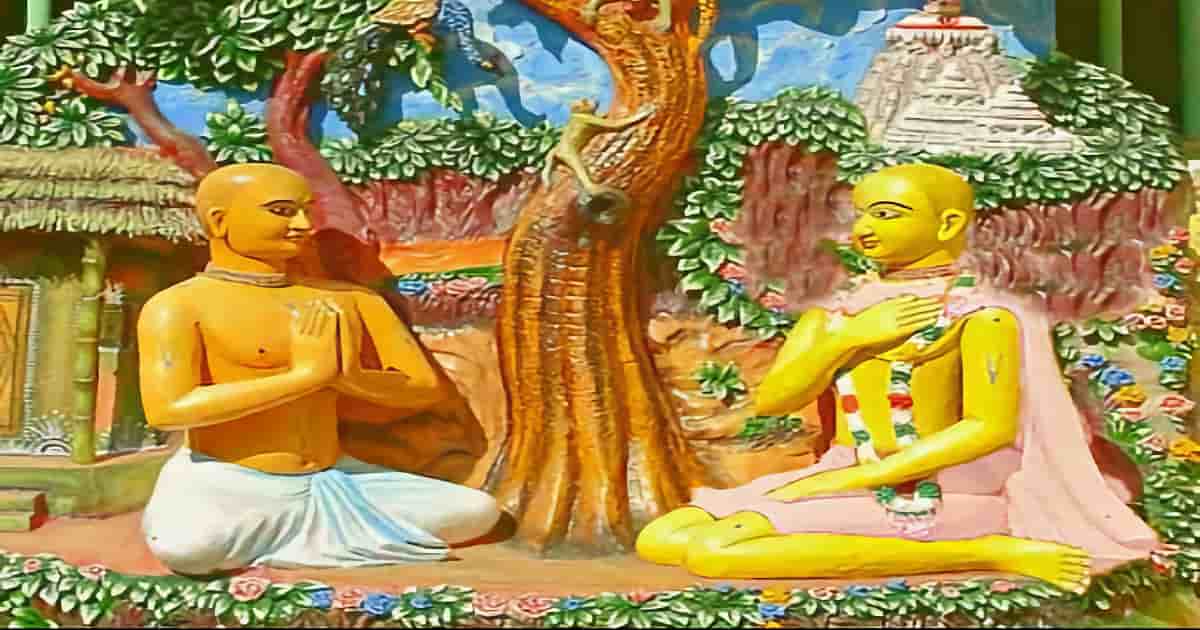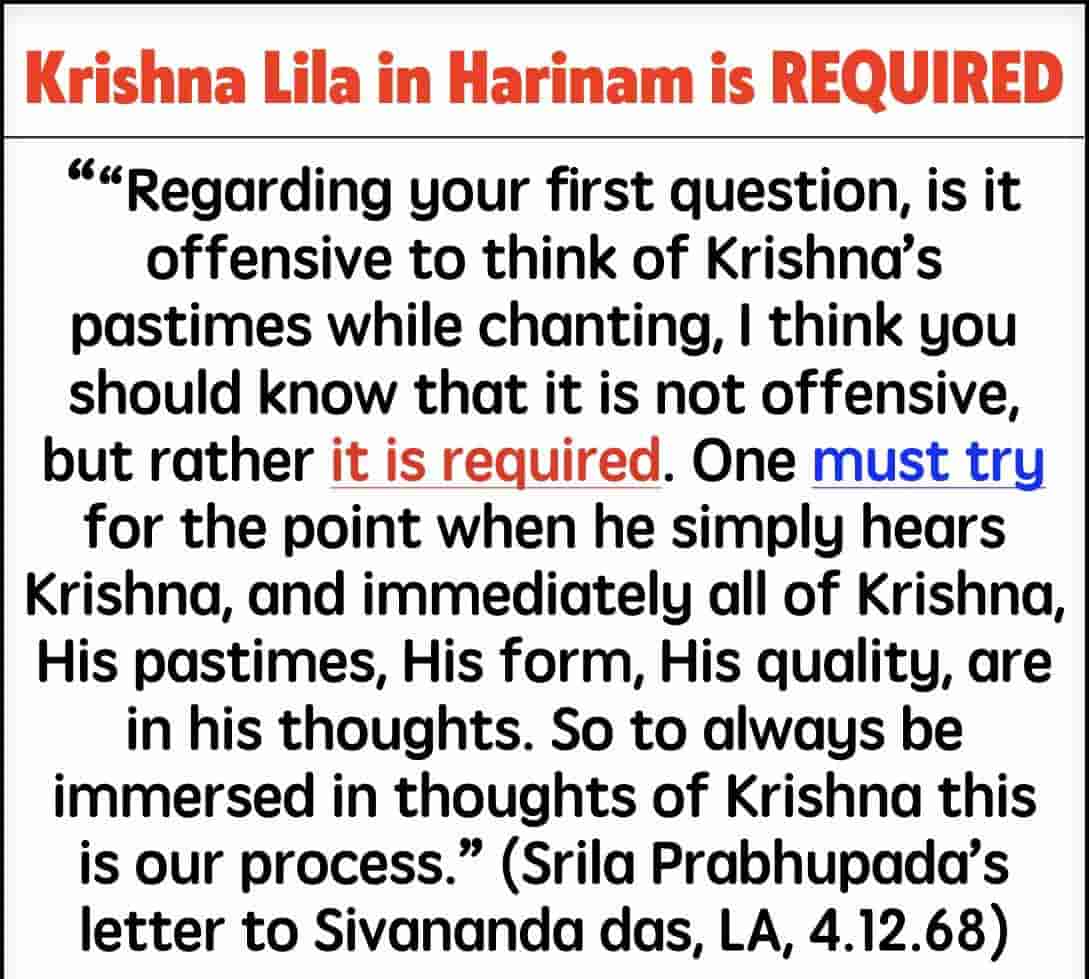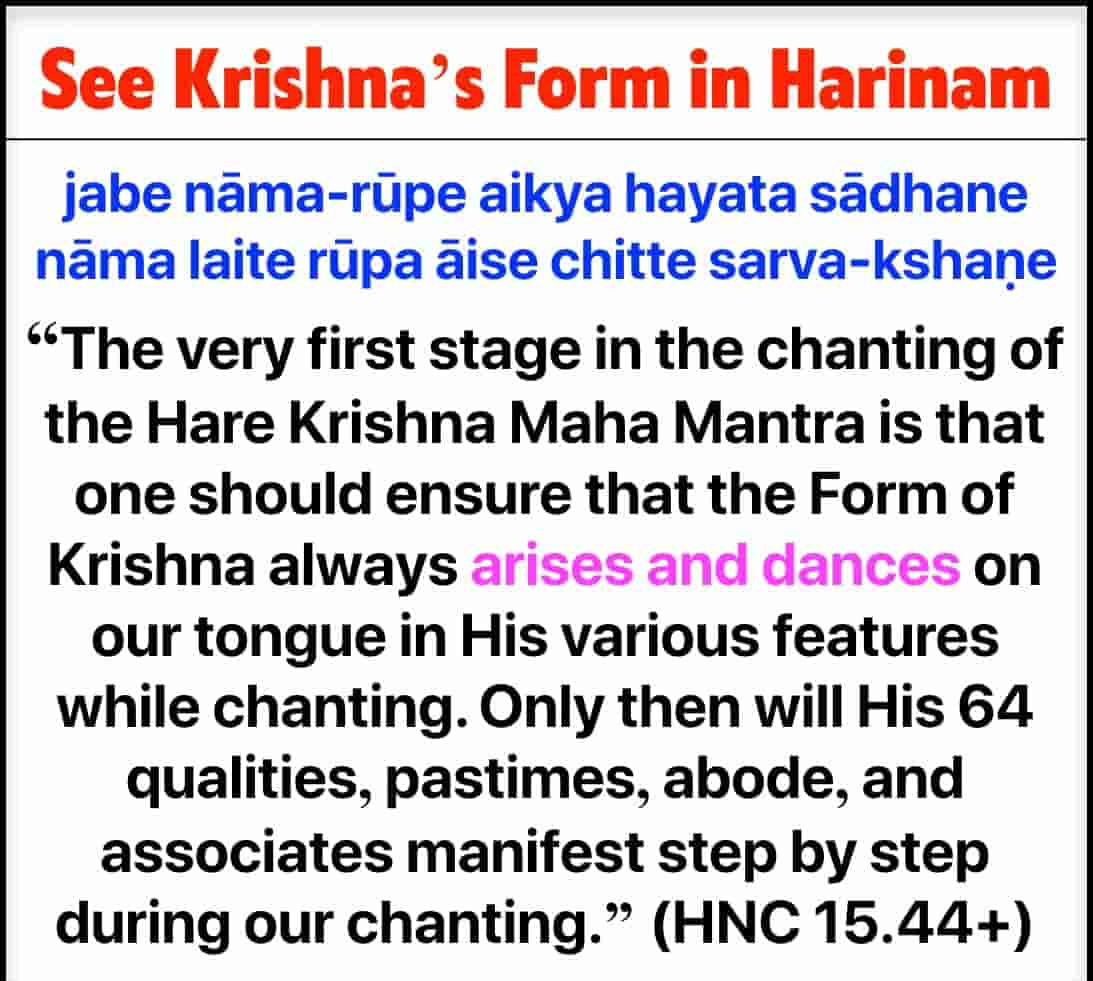
The Precise Method and Sequence to Chant the Hare Krishna Maha-mantra as per Harinama Chintamani
The correct method of Harinama Sadhana from Harinam Chintamani’s Bhajan Pranali (Chp 15) will be described here.
Here you will find the answer on how to quickly go from Namabhasa to Namarasa and thus from Kanistha to Uttama.
To remove the ten offenses which will block your advancement through the stages of chanting delineated in this article, please meditate on the all-forgiving and all-offense-destroying Nitya Ekachakra dhama in Goloka Vrindavana along with following these progressive steps of chanting Harinama.

The Perfect Chanting Method in Summary
HarinAma-sAdhana-krama is given by Srila Bhaktivinoda ThAkura is his commentary to Sri HarinAma ChintAmani 15.39-40:
sankhyA kariyA tulasira malAy nama-smarana va kirtanei upAsanA.
“Counting japa or kirtana of the Name on a tulasi mala is the method of worship.”
sei upAsanA-kramei sakala lAbhera moola.
“Advancing in this method of worship gradually is the very root of all attainment.”
sutarAng prathame atyalpa kAla nirjane ekAgra haiyA nAma karibe.
“Advancing in this method of worship gradually is the very root of all attainment.”
krame nAma sankhyA vriddhi karite karite nAmAnushilanera nairantarya evam vishaya pratibandhakera kshaya avashya haibe.
“Gradually by increasing the quantity and quality of remembrance of the Name more and more, you will attain continuity in its cultivation.
“At that time, all the insurmountable obstacles of our attraction to sense-objects will gradually cease to exist.”
bhakti-sAdhane dui prakAra Avritti Ache.
“There are two types of practices in bhakti-sadhana.”
ekati archana pravritti, ekati smarana kirtana pravritti.
“One is the path of Deity Worship. Other is the path of smarana, kirtana, and shravana.”
ubhayei samichina haileo smarana kirtana pravritti AIKANTIKA bhaktdigera madhye prabalA.
“Both are effective.
“But the second path of smarana, shravana, and kirtana is what one-pointed and serious devotees prefer much more over deity worship.”
kirtanera vishesha lAbha ei je tAhAte shravana, smarana, o kirtana ei tina angerai anushilana haite thAke.
“The most special benefit of kirtana is that the cultivation of these three most principle practices of svarupa-siddha-bhakti: hearing, remembering, and singing are all attained in one practice.”

The Five Stages of Remembrance
Srila Prabhupada quotes his own Gurudeva Srila Bhaktisiddhanta in Nectar of Instruction, Verse 8:
“When one is able to chant in ecstasy, he attains the stage of smaranavastha, the stage of remembering. Recollection (smarana), absorption (dharana), meditation (dhyana), constant remembrance (anusmriti), and trance (samadhi) are the five items of progressive krsna-smarana.”
“At first, remembrance of Krsna may be interrupted at intervals, but later remembrance proceeds uninterrupted. When remembrance is uninterrupted, it becomes concentrated and is called meditation.
“When meditation expands and becomes constant, it is called anusmrti.”
“By uninterrupted and unceasing anusmrti one enters the stage of samadhi, or spiritual trance.
“After smarana-dasa or samadhi has fully developed, the soul comes to understand his original constitutional position.”
The Intensity of Remembrance in These 5 Stages
Smarana or recollection means drop by drop remembrance with bigger breaks.
Dharana or absorption means bigger drops of remembrance with very few breaks.
Dhyana or meditation means a thin continuous flow of remembrance with very rare breaks.
Anusmriti or constant remembrance means a thick continuous flow of remembrance with no breaks at all.
And finally, Samadhi or trance means fully entering into that object of our remembrance in our spiritual form.
No One Can Skip Stages Especially in Harinama Sadhana Which Considers Offenses
When we open a tap, first the water flows drop by drop and then becomes a flow with no breaks.
We can’t go into Dharana or absorption in Harinam awithout mastering Smarana or recollection first, and so on.
Sometimes we lose patience and just want to skip directly to Samadhi, but that is not possible.
We cannot skip the steps or stages.
If we try to jump like that, we will not get the real thing (dusta phala karibe arjana).
Our advancement in remembering Harinama will only be illusory in our own imagination.
And if we patiently follow the proper sequence of these steps offenselessly, then by causeless mercy we can enter into the eternal pastimes in our spiritual form.
First Focus Only on Recollection
So how to advance in these five stages of remembrance in Harinama?
By fully focusing on Recollection or Smarana first.
Let us not be artifically greedy to jump to the higher stages of remembrance, as it is simply not possible to force our entry into the pastimes.
And how do we do that?
By trying to first awaken the remembrance of the divine form of Krishna while chanting Harinama.
This is recommended in the final 15th Chapter of Harinam Chintamani known as Bhajan Pranali, which is its very essence, as follows:

How To Start Harinama Sadhana?
nama-nami eka tattva visvasa kariya | dasa aparadha chadi nirjane basiya ||42||
“With strong faith that Harinama and Krishna are the Same, try to avoid the ten offenses and sit alone.”
sadhana krama ei. antarmukha bhakta-mahashaya prathame dasha aparadha tyaga purvaka kevala nama smarana o kirtanera nairantarya sadhana karibena. spashta nama uccharana-purvaka smarana-kirtana karibena. (bhaktivinoda bhashya)
“The proper method of Harinama Sadhana is as follows.
“The introvert and serious devotee first tries to give up the ten offenses and focuses on remembering and singing Harinama as constantly as possible and doing kirtana-remembrance with correct and clear pronunciation.”
How To Unite Krishna’s Form With Harinama
ati svalpa dine nama ha-iya sadaya | sri-syamasundara-rupe hayena udaya ||43||
“Then within a very few days, Harinama will be merciful upon you.
“And the form of Sri Shyamsundar will spontaneously arise in your heart while chanting.”
nama spashta, sthira, o sukhakar haile, sri shyamsundarera rupa dhyana karibena. haste mala sankhya, mane va mukhe krishna-namanusandhana karite karite namartha je rupa taha chinnayane darshan karite thakibena. athava srimurtira sanmukhe basiya rupa darshan o nama smaranadi karibena. (bhaktivinoda bhashya)
“When you come to the point of chanting Harinama with clear pronunciation, steadily without interruptions, and blissfully; please make an effort to meditate on the form of Sri Shyamsundara.”
“With japa mala in your hands, and after searching and searching for the divine meanings of Harinama with your mind and mouth, you will be able to behold with your transcendental eyes the first true meaning of Harinama which is Krishna’s Form.
“Another way to make Krishna’s Form One with Harinam is to sit in front of a (Realistic) Painting or a Deity and behold Krishna’s Form while remembering Harinama.”
jabe nama-rupe aikya hayata sadhane | nama laite rupa aise citte sarva-ksane ||44||
“When you achieve this Oneness of Harinam and Krishna’s Form, then that Form will constantly arise in your consciousness while chanting, hearing, or singing Harinama.”
How To Add Krishna’s Qualities To Harinama and His Form
tara kichu dine rupe guna kari yoga | sri-nama smarane guna karaya sambhoga ||45||
“After that, try to seek out the 64 qualities of Krishna in your remembrance while chanting Harinama, which in turn has already become One with Krishna’s Form.
“And try to merge these 64 qualities with Harinama and Krishna’s Form.”
namera sahita rupa ekatva prapta haileo krishna-guna sakala smarane aanite abhyasa karibena. (bhaktivinoda bhashya)
“When Krishna’s Form has united with Harinama, endeavor to bring all the 64 qualities of Krishna into remembrance while chanting Harinama.”
svalpa-dine nama rupa guna eka haya | nama laite sarva-ksane tinera udaya ||46||
“Again in a few days, Harinama, Krishna’s Form, and Krishna’s Qualities will become One. And as soon as you chant or hear Harinama, all Three will arise at every moment.”
How To Unite Krishna’s Pastimes With Harinama, Form, and Qualities
mantra dhyana mayi ei nama upasana | prathamika dhara jani kare vibhavana ||47||
“Then you will enter into the preliminary visualization and meditational worship of the divine Pastimes of Krishna in His Yogapeeth, etc. in Harinam known as mantradhyanmayi upasana.”
How Does Hare Krishna Nama Lila Rasa Arise?
nama, rupa o guna ekatva abhyasta haile prathame mantradhyanmayi lilara smarana kariya tahara nama-rupa-gunera sahita aika kariya laibena. ei samayei nama rasera udaya haya. mantradhyanmayi bhavana dridha haile svarasiki ashtakala lila dhyana karite karite sampurna rasodaya haibe. (bhaktivinoda bhashya)
“When Harinam, Krishna’s Form, and Krishna’s Qualities have become One with each other in your remembrance, then first remember the Mantradhyanmayi Lila while chanting and try to also make it One with the Three.
“This is when Hare Krishna Nama Rasa truly arises.”
“When you get fixed in this Mantradhyanmayi Lila remembrance while chanting, then take up the repeated remembrance of Svarasiki Ashtakaliya Lila and by that complete Rasa will fully arise.”
How Does One Progress From Kanishtha to Uttama?
ei sadhanera arambha-kale sadhaka praya kanishtha bhava prapta. anativilambe sadhaka uttama sadhu-sange madhyama bhakta haiya, avasheshe uttama bhakta madhye parinita hana. kanisthavasthaya kichu dina namabhyasa haya. namabhyase anartha dura hailei shuddha namadhikara o vaishnava sevadhikara haya. (bhaktivinoda bhashya)
“When one begins this Harinama Sadhana, one is a kanistha or neophyte devotee.
“But without much delay, by following this Sadhana correctly and by the association of an uttama devotee, one will become a madhyama devotee.
“And at the end of this Harinama Sadhana, one will be counted among the uttama devotees.”
“In the kanistha stage, one will have to practice this Harinam Sadhana for some time.
“When the anarthas or unwanted desires go away by this Harinama Sadhana, one gets the qualification to chant pure Harinama and to truly serve the Vaishnavas.”
One Has to Make An Effort to Remember While Chanting
Srila Namacharya Haridasa Thakura states in Harinam Chintamani 15.43 to Lord Gauranga Mahaprabhu Himself and Srila Bhaktivinoda Thakura explains it elaborately in his commentary as follows:
shyamsundarera rupa DHYANA KARIBENA
”MAKE AN EFFORT TO MEDITATE on the form of Sri Shyamsundara.”
and
mane va mukhe krishna-NAMANUSANDHANA KARITE KARITE
”after SEARCHING AND SEARCHING AFTER THE DIVINE MEANINGS of Harinam with your mind and mouth.”
All other instructions given by all other Acharyas in their books, letters, and conversations are subservient, secondary to, should be understood in relation to, and cannot contradict the above clearcut instructions of Srila Namacharya Haridasa Thakura himself, which are directly endorsed by the Supreme Lord Gauranga Mahaprabhu and Srila Bhaktivinoda Thakura.
No one is a greater authority on Harinama than Srila Haridasa Thakura, we all agree with that.
So why are we arguing here that we don’t have to think of Krishnaʼs form and pastimes while chanting or singing Harinama?
Secondly, when Harinam Chintamani instructs us to start meditating on Krishnaʼs form and search after meanings of Harinama after our chanting has become steady, clear, and blissful; the remembrance of Krishnaʼs form while chanting is no longer artificial.
Some spontaneity is already there as our chanting has become blissful or sukhakar.
So that should be combined with our effort to search for the meanings of Harinama.
And yes the effort should be there to remember.
Otherwise what is the use of the free will given to every soul by the Lord in the form of the choice to remember the Lord or to forget Him at every second. sai vai manah krishna padavindayoh..
How is it possible that all the scriptures instruct us to remember the Lord 24/7, but we are not supposed to make any effort to remember anything at the time of chanting and just hear the sound? Isn’t that a contradiction?
This crystal-clear quote of Srila Prabhupada removes a major misconception among devotees that we have to just hear the sound while chanting and not try to actually recollect the form of the Lord while chanting
Srila Prabhupada’s letter to Sivananda das, Los Angeles, 4 December, 1968:
“Regarding your first question, is it offensive to think of Krishna’s pastimes while chanting, I think you should know that it is not offensive, but rather it is required.
“One must try for the point when he simply hears Krishna, and immediately all of Krishna, His pastimes, His form, His quality, are in his thoughts.
“So to always be immersed in thoughts of Krishna this is our process.
“When we are full in Krishna then where there can be any chance for maya in us?
“So this is our duty to remember Krishna’s pastimes.
“One who cannot remember Krishna, let him always hear Hare Krishna, and then when he has perfected this art, then always he will remember Krishna, His activities, His qualities, and so on.”
The goal of chanting is to actually remember the Lord 24/7, not to only hear the sound
Srila Prabhupada in Bhagavad Gita As It Is Introduction:
“There is no difference, because Krsna and Krsna’s name are nondifferent.
“In the absolute status there is no difference between reference and referent.
“Therefore we have to practice remembering the Lord always, twenty-four hours a day, by chanting His names and molding our life’s activities in such a way that we can remember Him always.”
Sveccha Purvika or Voluntary Recollection is Recommended
Srila Bhaktivinoda Thakura’s commentary to Shikshashtakam:
“After anartha-nivrtti follows nairantarya, or undeviating steadiness in serving, then sveccha-purvika, voluntary meditation on Krsna’s pastimes by which one develops spontaneous attraction for them; and then svarasiki, the spontaneous revelation of Krsna’s pastimes even without one’s expectation. Only after these three stages comes the final perfection of prema.”
Trying to remember the pastimes without being established in the remembrance of Krishna’s form and qualities in Harinama is not the same as actually seeing the real pastimes face to face after Nam, rupa, and guna have become One with Harinam.
The Fragrance of the Qualities Manifests the Pastimes
Just like no one has to tell you that you have eaten fully to your satisfaction, you will know when Krishna’s form will start arising while chanting Harinama.
Then you will slowly get closer and closer in remembrance to all the minute details of Krishna’s form.
After that, Krishna’s qualities will arise in Harinam, like an aroma radiating from the flower (form).
At that point, you will be in total bliss as the 64 qualities of the Lord spontaneously splash all over your consciousness while chanting Harinam.
After that, you will be able to truly get the real glimpses of His pastimes.
To summarize my answer, if your advancement in remembrance of the Form or Qualities is real during chanting Harinama, then you will yourself know without doubt and there will no need for anyone else to tell you that you are truly advancing.